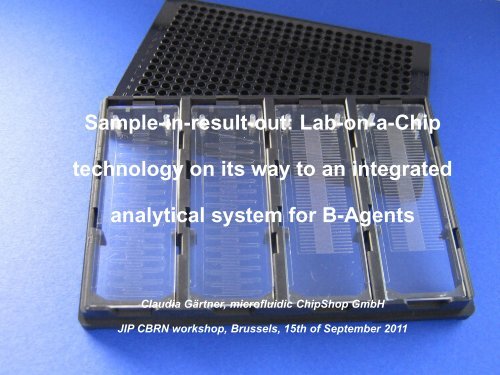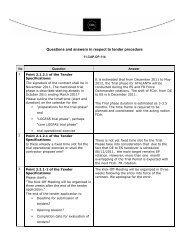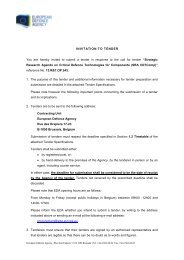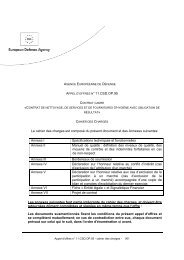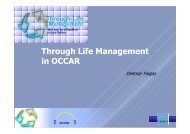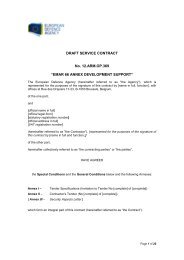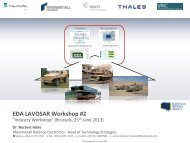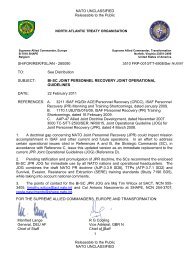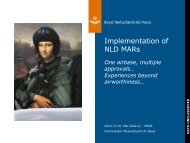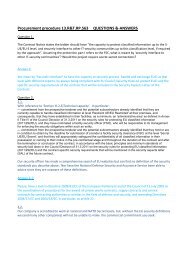Briefing by ChipShop
Briefing by ChipShop
Briefing by ChipShop
You also want an ePaper? Increase the reach of your titles
YUMPU automatically turns print PDFs into web optimized ePapers that Google loves.
Sample-in-result-out: Lab-on-a-Chip<br />
technology on its way to an integrated<br />
analytical system for B-Agents<br />
Claudia Gärtner, microfluidic <strong>ChipShop</strong> GmbH<br />
JIP CBRN workshop, Brussels, 15th of September 2011
OUTLINE<br />
1. Miniaturization – What does this mean<br />
2. The overall goal<br />
3. Technical & biological elements<br />
4. Summary & conclusion
SAMPLE-IN-RESULT-OUT<br />
Requires a multidisciplinary team
PROJECT, TEAM & RESSOURCES<br />
1. microfluidic <strong>ChipShop</strong> GmbH<br />
(Germany), SME<br />
Microfluidics<br />
2. Clemens GmbH (Germany), SME<br />
3. Institut für Mikrobiologie der<br />
Bundeswehr (Germany), Institute<br />
4. Friedrich-Löffler-Institut (Germany),<br />
Institute<br />
5. Joanneum Research (Austria),<br />
Institute<br />
Array<br />
6. Bertin Technologies (France),<br />
Industry<br />
1. microfluidic <strong>ChipShop</strong> GmbH<br />
(Germany), SME<br />
2. Friedrich-Löffler-Institut (Germany),<br />
Institute<br />
3. IMM, Institut für Mikrotechnik Mainz<br />
(Germany), Insitute<br />
4. University of Roviria Spain<br />
5. iMICROQ (Spain), SME<br />
6. Institute for Physical Biology,<br />
(Slovenia) SME<br />
7. Bertin Technologies (France),<br />
Industry<br />
8. Cedralis (France) SME
MICROFLUIDICS<br />
Microfluidics – Present and Future<br />
Blood vessels in<br />
the lung<br />
Inkjet printer heads<br />
Lab-on-a-Chip
LAB-ON-A-CHIP – WHAT DO WE GAIN<br />
‣ Minimization of analysis times – from hours to minutes or seconds<br />
‣ Reduction of sample volumes <strong>by</strong> orders of magnitude<br />
‣ Novel ways to obtain information<br />
‣ Increased sample and data throughput<br />
‣ Increased performance<br />
‣ Simpler handling of complex analytical tasks<br />
‣ New ways to conduct a reaction<br />
‣ Realization of portable systems for on-site-analysis<br />
‣ Little space necessary<br />
‣ On-line measurement is possible
TARGET PATHOGENS<br />
Bacteria:<br />
• Yersinia pestis<br />
• Francisella tularensis<br />
• Burkholderia mallei<br />
• Burkholderia pseudomallei<br />
• Brucella melitensis<br />
• Brucella abortis<br />
• Coxiella burnetti<br />
Later:<br />
• Bacillus anthracis<br />
• Ortho pock virus
SAMPLE-IN-RESULT-OUT<br />
WHAT DOES THIS MEAN<br />
The development of a system for the mobile and<br />
doubtless identification of biological pathogens.<br />
Sample enrichment<br />
Filtration<br />
DNA extraction<br />
DNA amplification<br />
Detection – different options
STEP 1: SAMPLE ENRICHMENT<br />
cone interface<br />
septum<br />
needle<br />
Time:<br />
15 min<br />
filter<br />
on-chip membrane:<br />
mesh width of 5 µm<br />
Module 1:Chip with<br />
Integrated filter<br />
membranes<br />
Prototype<br />
Design cone-chip<br />
interface<br />
Concept<br />
Design and fluidic<br />
tests<br />
Integration into<br />
system<br />
Fixed sampling<br />
protocol
STEP 2: DNA EXTRACTION<br />
Modul 1<br />
chamber volume<br />
25µl<br />
Time:<br />
3 min<br />
Module 2<br />
chamber volume<br />
120 µl<br />
Evaluation of process<br />
time, temperature and<br />
efficiency<br />
Fluidical tests:<br />
Design<br />
Fluidical and<br />
functional tests<br />
Integration into<br />
chip<br />
Fixed lysis<br />
protocol
STEP 3: PCR<br />
qPCR sucessful<br />
tested in 41 Cycle<br />
chip<br />
Modul 1<br />
41-Zyklen 3-step PCR-Chip<br />
PCR in biplex<br />
developed and<br />
pathogen combination<br />
successful tested<br />
20 min<br />
44 -Zyklen 2-step PCR-<br />
Chip Modul 1<br />
try reagent storage<br />
established<br />
together with WP8<br />
partners<br />
Design<br />
Fluidical and<br />
functional tests<br />
Integration into<br />
chip<br />
PCR<br />
protocol
WP2 Detection modul<br />
Chemiluminescent 2<br />
Reagenz: PS-ATTO<br />
18-well chip<br />
for establishment<br />
of PCR-ELISA<br />
PCR-ELISA<br />
• Fixed hybridisation<br />
conditions<br />
• Fixed hybridisation<br />
protocol<br />
Single lane readout<br />
device succsessful tested<br />
Modul 2<br />
Design<br />
Fluidical and<br />
functional tests<br />
Integration into<br />
chip<br />
Fixed PCR-ELISA<br />
protocol
SAMPLE-IN-RESULT-OUT<br />
INTEGRATION ON CHIP
PROOF-OF-CONCEPT: YERSINIA PESTIS<br />
SINGLEPLEX AND BIPLEX PCR ON CHIP<br />
Yersinia Pestis PCR<br />
template conc.: 10 pg/ µl ~ 1900 copies/ µl<br />
Targets: IS200 178 bp<br />
Caf1 240 bp<br />
pla 232 bp<br />
Chip: PCR performed on 41-cycle 3-step Chip<br />
with 2-step thermal setup:<br />
95°C, 60°C, 60°C<br />
41-cycle-chip<br />
_<br />
IS200 caf1 pla IS + IS +<br />
caf1 pla<br />
300 bp<br />
200 bp<br />
100 bp<br />
Results: singleplex<br />
IS200<br />
Caf1<br />
pla<br />
positive<br />
positive<br />
positive<br />
41-cycle PCR-Chip<br />
Results: biplex<br />
IS200 + Caf1 positive / positive<br />
IS200 + pla positive / positive
COMPLETE PROCESS WITH SINGLE<br />
MODULES – THE SET-UP<br />
Waste<br />
2-way valve<br />
Chip with lyophilized<br />
reagents<br />
Sample take-up<br />
Liquid reservoirs<br />
Thermocycler<br />
External valve block
AND FINALLY – THE INTEGRATED<br />
SYSTEM<br />
But: Just a first version in a series of lab-on-a-chip<br />
instrument set-ups!
CONCLUSION<br />
‣ All single steps (lysis, nucleic acid extraction, dried reagent<br />
storage, PCR) work on chip.<br />
‣ Combination of single modules work.<br />
‣ Novel PCR concept massively decreases the overall raction<br />
time (less then 20 minutes for 41 cycles compared to more<br />
then 1 hour with the Roche Light Cycler).<br />
‣ Target timeline 30 min with further optimization realistic.
CONCLUSION PART 2<br />
….still some time to go to the ultimate universal<br />
analytical tool!
NEXT STEPS<br />
‣ Process set-up for the integrated system.<br />
‣ Time optimization needs to be done – goal of 20 – 30 minutes<br />
for the overall process.<br />
‣ Evaluation of detection methods in the overall set-up.<br />
‣ Complete process set-up in the integrated chip.<br />
‣ Parallelization of several PCR reactions and multiplexing<br />
needs to be done.
CONTACT &<br />
ACKNOWLEDGEMENT<br />
Dr. Claudia Gärtner<br />
microfluidic <strong>ChipShop</strong> GmbH<br />
Stockholmer Str. 20<br />
D – 07747 Jena<br />
Germany<br />
Phone: + 49 (0) 36 41– 64 31 21<br />
Phone: + 49 (0) 36 41– 64 31 21<br />
Claudia.Gaertner@microfluidic-<strong>ChipShop</strong>.com<br />
Acknowledgement for partial support of the work via:<br />
EDA-project PathoID Chip<br />
European Community´s Seventh Framework Programme<br />
(FP7/2007-2013) under grant agreement n° [261810]


